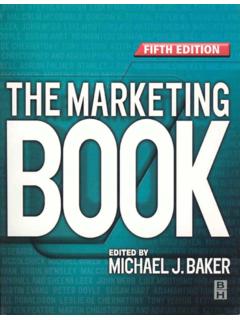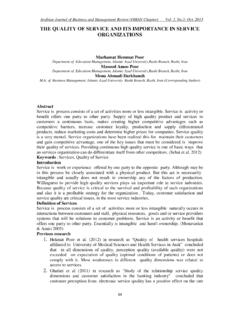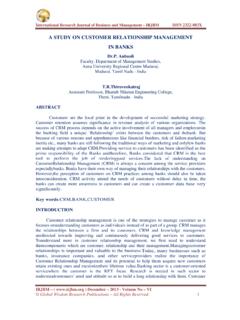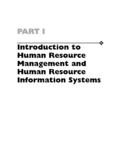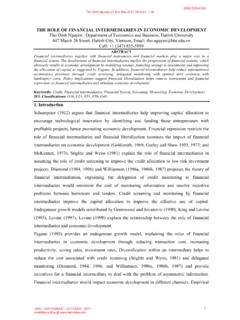Transcription of The Marketing Book
1 The Marketing BookThis Page Intentionally Left BlankThe Marketing BookFifth EditionEdited byMICHAEL J. BAKEROXFORDAMSTERDAMBOSTON LONDON NEW YORK PARISSAN DIEGOSAN FRANCISCO SINGAPORE SYDNEY TOKYOB utterworth-HeinemannAn imprint of Elsevier ScienceLinacre House, Jordan Hill, Oxford OX2 8DP200 Wheeler Road, Burlington MA 01803 First published 1987 Reprinted 1987, 1990 (twice)Second edition, 1991 Reprinted 1992, 1993 Third edition, 1994 Reprinted 1995, 1997 Fourth edition 1999 Reprinted 2000, 2001 Fifth edition, 2003 Copyright 2003 Michael Baker. All rights reservedCopyright 2003 contributors of individual chapters. All rights reservedThe right of Michael Baker and the individual contributors to be identifiedas the authors of this work has been asserted in accordance with the Copyright,Designs and Patents Act 1988No part of this publication may be reproduced in any material form (includingphotocopying or storing in any medium by electronic means and whetheror not transiently or incidentally to some other use of this publication)
2 Withoutthe written permission of the copyright holder except in accordance with theprovisions of the Copyright, Designs and Patents Act 1988 or under the terms ofa licence issued by the Copyright Licensing Agency Ltd, 90 Tottenham Court Road,London, England W1T 4LP. Applications for the copyright holder s written permission to reproduce any part of this publication should be addressedto the publisherBritish Library Cataloguing in Publication DataA catalogue record for this book is available from the British LibraryLibrary of Congress Cataloguing in Publication DataA catalogue record for this book is available from the Library of CongressISBN 0 7506 5536 4 For information on all Butterworth-Heinemann publications visitour website at.
3 By Genesis Typesetting, Rochester, KentPrinted and bound in Great BritainContentsList of illustrationsxvList of tablesxixList of contributorsxxiiiPreface to the fifth editionxxxiiiPart One Organization and Planning for Marketing11 One more time what is Marketing ?3 Michael J. BakerIntroduction3 Marketing as a managerial orientation4 Marketing myopia a watershed5 Life cycles and evolution7 Marketing misunderstood8 The Marketing function9 Relationship marketing11 Summary14 References15 Further reading152 Postmodern Marketing : everything must go!16 Stephen BrownGrand opening offer16No down payment17 Money back guarantee18 Batteries not included19 Limited time only22 One careful owner24 This way up25 Open other side27 Closing down sale28 References29 Further reading31viContents3 Relationship marketing32 Lisa O Malley and Caroline TynanIntroduction32 Relationship Marketing defined33 History of relationship marketing34 Focal relationships39 Models of relationship development40 Critique and emerging issues44 Conclusion47 References484 The basics of Marketing strategy53 Robin WensleyStrategy.
4 From formulation to implementation53 The nature of the competitive market environment55 The codification of Marketing strategy analysis in terms of three strategies,four boxes and five forces58 The search for generic rules for success amidst diversity60 Models of competition: game theory versus evolutionary ecology62 Characterizing Marketing strategy in terms of evolving differentiation in time and space66 Research in Marketing strategy: fallacies of free lunches and the nature ofanswerable research questions70 The recourse to processes, people and purpose in Marketing as well as strategy as a whole75 The new analytics: resource advantage , co-evolution and agent-based modelling80 Conclusions: the limits of relevance and the problems of application81 References and further reading825 Strategic Marketing planning: theory and practice87 Malcolm McDonaldSummary87 Introduction871 The Marketing planning process902 Guidelines for effective Marketing planning1013 Barriers to Marketing planning109 Summary115 References116 Further reading116 Part Two The Framework of Marketing1176 Consumer decision making: process, level and style119 Gordon R.
5 FoxallIntroduction119 The consumer decision process121 Levels of consumer involvement125 ContentsviiConsumers decision styles127 Implications for Marketing management132 Summary and conclusion138 References138 Further reading1407 Business-to-business Marketing : organizational buying behaviour,relationships and networks142 Peter W. Turnbull and Sheena LeekIntroduction142 The realities of business markets144 organizational buying structures144 Models of organizational buying behaviour152 Conclusion165 References166 Further reading1698 Marketing research171 John WebbIntroduction171 Definitions of the role of Marketing research172 Types of research173 The process of Marketing research174 Secondary data175 Quantitative primary data177 Questionnaires and their design180 Qualitative research methods180 The research process and measurement184 Attitudes and their measurement186 Sampling189 Analysis of the results192 Presentation of the final report194 Conclusion195 References1959 Quantitative
6 Methods in marketing197 Luiz Moutinho and Arthur MeidanIntroduction197 Multivariate methods200 Regression and forecasting techniques206 Statistical decision theory or stochastic methods219 Deterministic operational research methods226 Causal models235 Hybrid models236 Network programming models237viiiContentsConclusion240 References241 Further reading24410 Market segmentation246 Martin EvansChapter objectives246 Introduction246 Historical perspective247 Segmentation criteria and categories248 Traditional segmentation bases249 Data-driven segmentation258 Targeting276 Positioning278 Conclusions280 Review questions280 References281 Further reading282 Part Three Managing the Marketing Function28511 Managing the Marketing mix287 Peter DoyleIntroduction287 The traditional approach to the Marketing mix288 The accounting approach to the Marketing mix289 Value-based marketing291 The Marketing mix and shareholder value294 Making Marketing mix decisions298 Summary311 References312 Further reading31312 New product development314 Susan HartIntroduction314 The process of developing new products314 The stages of the new product development process316 Usefulness of models322 The multiple convergent approach331 Managing the people in NPD333 Summary338 References338 Further reading341 Contentsix13 Pricing342 Adamantios
7 DiamantopoulosIntroduction342Is price reallythat important?344 The drivers of profit: price, volume and cost345 Price from the customer s perspective348 Understanding price sensitivity351 Conclusion356 References35614 Selling and sales management360 Bill DonaldsonIntroduction360 The changing role of salespeople360 The costs of personal selling362 What we expect salespeople to do the sales process363 Sales management issues366 Conclusion369 References370 Further reading37015 Brand building372 Leslie de ChernatonyIntroduction372 Spectrum of brand interpretations373A model for strategically building brands383 Summary392 References393 Further reading39416 The integration of Marketing communications395 Tony YeshinThe blurring of the edges of
8 Marketing communications395 The strategic challenges facing organizations396 Strategic Marketing communications396 The integration of Marketing communications397 Defining integrated Marketing communications397 The impact of external factors on Marketing communications400 The driving forces behind the growth of integrated Marketing communications404 The impact on Marketing communications405 Relationship marketing406 The benefits of integrated Marketing communications407xContentsThe process of achieving integration409 organizational approaches to integration410 The barriers to integration413 The consumer and integrated Marketing communications414 International dimensions of integrated Marketing communications415 Integrated Marketing communications a summary416 References41717 Promotion419 Keith CrosierIntroduction419 The promotional mix419 The promotional budget426 Deploying the promotional mix429 Developing the message432 Delivering the message433 The medium and the message436A mix within a mix: synergy or counter-synergy?
9 436 Pulling it all together: the promotional plan437 From the plan to the brief439 The actors in the system439 Working relationships441 Choosing the collaborator443 Remunerating the working partner445 Measuring campaign effectiveness449 Understanding the context451 References45518 Sales promotion458 Sue Peattie and Ken PeattieIntroduction458 Sales promotion defined458 Understanding sales promotion a tale of price and prejudice459 Sales promotion and advertising the line and the pendulum465 The growing importance of sales promotion467 Consumers and sales promotion469 Communicating through sales promotions471 Building relationships through promotions473 Sales promotion s role
10 In the Marketing mix474 Sales promotions the most manageable P?475 Sales promotions mismanagement475 The future of sales promotion477 Summary the changing concept of sales promotion479 References481 Further reading483 Contentsxi19 Integrating customer relationship management and supply chainmanagement485 Martin Christopher and Adrian PayneIntroduction485 The decline of the brand: the need for integrated CRM and SCM strategies485 Competing through capabilities487A strategic framework for CRM490 Supply chain management494 The impact of superior SCM performance496 CRM and SCM: their role in improving customer service497 Developing market-driven CRM and SCM strategies499 Summary.
